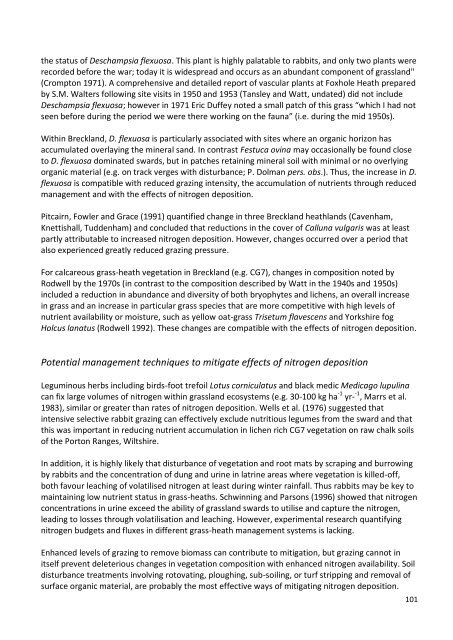Securing Biodiversity in Breckland - European Commission
Securing Biodiversity in Breckland - European Commission
Securing Biodiversity in Breckland - European Commission
You also want an ePaper? Increase the reach of your titles
YUMPU automatically turns print PDFs into web optimized ePapers that Google loves.
the status of Deschampsia flexuosa. This plant is highly palatable to rabbits, and only two plants wererecorded before the war; today it is widespread and occurs as an abundant component of grassland"(Crompton 1971). A comprehensive and detailed report of vascular plants at Foxhole Heath preparedby S.M. Walters follow<strong>in</strong>g site visits <strong>in</strong> 1950 and 1953 (Tansley and Watt, undated) did not <strong>in</strong>cludeDeschampsia flexuosa; however <strong>in</strong> 1971 Eric Duffey noted a small patch of this grass “which I had notseen before dur<strong>in</strong>g the period we were there work<strong>in</strong>g on the fauna” (i.e. dur<strong>in</strong>g the mid 1950s).With<strong>in</strong> <strong>Breckland</strong>, D. flexuosa is particularly associated with sites where an organic horizon hasaccumulated overlay<strong>in</strong>g the m<strong>in</strong>eral sand. In contrast Festuca ov<strong>in</strong>a may occasionally be found closeto D. flexuosa dom<strong>in</strong>ated swards, but <strong>in</strong> patches reta<strong>in</strong><strong>in</strong>g m<strong>in</strong>eral soil with m<strong>in</strong>imal or no overly<strong>in</strong>gorganic material (e.g. on track verges with disturbance; P. Dolman pers. obs.). Thus, the <strong>in</strong>crease <strong>in</strong> D.flexuosa is compatible with reduced graz<strong>in</strong>g <strong>in</strong>tensity, the accumulation of nutrients through reducedmanagement and with the effects of nitrogen deposition.Pitcairn, Fowler and Grace (1991) quantified change <strong>in</strong> three <strong>Breckland</strong> heathlands (Cavenham,Knettishall, Tuddenham) and concluded that reductions <strong>in</strong> the cover of Calluna vulgaris was at leastpartly attributable to <strong>in</strong>creased nitrogen deposition. However, changes occurred over a period thatalso experienced greatly reduced graz<strong>in</strong>g pressure.For calcareous grass-heath vegetation <strong>in</strong> <strong>Breckland</strong> (e.g. CG7), changes <strong>in</strong> composition noted byRodwell by the 1970s (<strong>in</strong> contrast to the composition described by Watt <strong>in</strong> the 1940s and 1950s)<strong>in</strong>cluded a reduction <strong>in</strong> abundance and diversity of both bryophytes and lichens, an overall <strong>in</strong>crease<strong>in</strong> grass and an <strong>in</strong>crease <strong>in</strong> particular grass species that are more competitive with high levels ofnutrient availability or moisture, such as yellow oat-grass Trisetum flavescens and Yorkshire fogHolcus lanatus (Rodwell 1992). These changes are compatible with the effects of nitrogen deposition.Potential management techniques to mitigate effects of nitrogen depositionLegum<strong>in</strong>ous herbs <strong>in</strong>clud<strong>in</strong>g birds-foot trefoil Lotus corniculatus and black medic Medicago lupul<strong>in</strong>acan fix large volumes of nitrogen with<strong>in</strong> grassland ecosystems (e.g. 30-100 kg ha -1 yr- -1 , Marrs et al.1983), similar or greater than rates of nitrogen deposition. Wells et al. (1976) suggested that<strong>in</strong>tensive selective rabbit graz<strong>in</strong>g can effectively exclude nutritious legumes from the sward and thatthis was important <strong>in</strong> reduc<strong>in</strong>g nutrient accumulation <strong>in</strong> lichen rich CG7 vegetation on raw chalk soilsof the Porton Ranges, Wiltshire.In addition, it is highly likely that disturbance of vegetation and root mats by scrap<strong>in</strong>g and burrow<strong>in</strong>gby rabbits and the concentration of dung and ur<strong>in</strong>e <strong>in</strong> latr<strong>in</strong>e areas where vegetation is killed-off,both favour leach<strong>in</strong>g of volatilised nitrogen at least dur<strong>in</strong>g w<strong>in</strong>ter ra<strong>in</strong>fall. Thus rabbits may be key toma<strong>in</strong>ta<strong>in</strong><strong>in</strong>g low nutrient status <strong>in</strong> grass-heaths. Schw<strong>in</strong>n<strong>in</strong>g and Parsons (1996) showed that nitrogenconcentrations <strong>in</strong> ur<strong>in</strong>e exceed the ability of grassland swards to utilise and capture the nitrogen,lead<strong>in</strong>g to losses through volatilisation and leach<strong>in</strong>g. However, experimental research quantify<strong>in</strong>gnitrogen budgets and fluxes <strong>in</strong> different grass-heath management systems is lack<strong>in</strong>g.Enhanced levels of graz<strong>in</strong>g to remove biomass can contribute to mitigation, but graz<strong>in</strong>g cannot <strong>in</strong>itself prevent deleterious changes <strong>in</strong> vegetation composition with enhanced nitrogen availability. Soildisturbance treatments <strong>in</strong>volv<strong>in</strong>g rotovat<strong>in</strong>g, plough<strong>in</strong>g, sub-soil<strong>in</strong>g, or turf stripp<strong>in</strong>g and removal ofsurface organic material, are probably the most effective ways of mitigat<strong>in</strong>g nitrogen deposition.101





